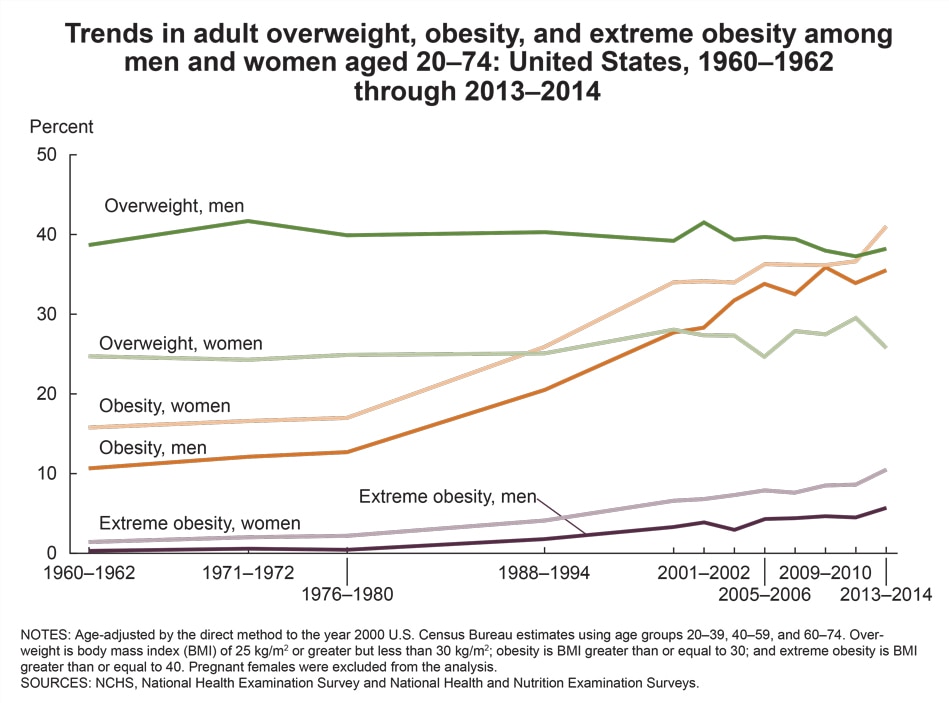A trying-to-be-brief discussion of weight
A brief discussion
of weight.
One thing that set
me off on my current quest to understand health better was that I
wanted to get back to my pre-pregnancy weight, even though my doctor
thought that my weight was just fine. I don't consider myself to be particularly obsessed with weight, but I do think about it. Over the course of my lifetime, people have gotten fatter. Here's a chart (from https://www.niddk.nih.gov/health-information/health-statistics/overweight-obesity)
Interestingly, the percentage who are classed as overweight has stayed about the same (the so-called "overweight" bracket seems to be associated with similar health outcomes to the "Normal" bracket). The general increase comes from people who are in the part of the charts where weight seems to have a real negative impact on their health.
Enter the diet industry. Thinking about weight loss is so easy; picking a number, setting a goal, the idea that you can fix all your problems with a simple calories-in vs. calories-out calculation. I’ve always had a bathroom scale in the house, and I think most people do.1 That makes weigh-ins convenient. On top of that, you have the cultural and commercial pressure to diet – the dieting industry is enormous (over $70 billion spent in the US in 20182) and it wants your money. With all that advertising and obsession about appearance, a lot of weight loss ambition is driven by anxiety over appearance more than a desire to be healthier.
Enter the diet industry. Thinking about weight loss is so easy; picking a number, setting a goal, the idea that you can fix all your problems with a simple calories-in vs. calories-out calculation. I’ve always had a bathroom scale in the house, and I think most people do.1 That makes weigh-ins convenient. On top of that, you have the cultural and commercial pressure to diet – the dieting industry is enormous (over $70 billion spent in the US in 20182) and it wants your money. With all that advertising and obsession about appearance, a lot of weight loss ambition is driven by anxiety over appearance more than a desire to be healthier.
So let’s get this
straightened out (a little). In general there are two
dominant, polarizing narratives about excess weight. One is that it’s
a result of poor self-control and weak-mindedness. The other is that
it’s all about a person’s genes, so there’s nothing they can do
about it.3
Neither of those stories is very helpful. I actually find it more helpful to blame the world in general: in recent decades (and centuries) our environment has
changed to make us more sedentary (driving cars and
working desk jobs), while simultaneously there has been a rise in
consumption of junk food, sugar, and empty calories in general (also
driven by food companies pursuing profits).
You’d be hard-pressed to find an obese hunter-gatherer
or an obese subsistence farmer. A pattern of moving throughout the
day, eating natural whole foods at mealtimes, where meals take a lot
of labor to prepare, does not lead to obesity. Sitting in front of a
glowing screen while eating highly processed snack foods all day and
half the night does, and even if you’re still skinny after all
that, it doesn’t mean you’re healthy.
There are small things that
you can do to change your own environment, short of banning all cars and cell phones, but I’ll get into that
later. First, I am going to go out on a limb and say that yes, there
is such thing as a healthy weight. I know that for myself, I feel
better when I’m under 150 pounds (at which point my back starts to
hurt) and over about 135 pounds, at which point I start to feel run
down and wrung out, so 135-150 is an okay range for me, personally.
Establishing an ideal weight guideline for people in general is more
of a problem, because you can do broad epidemiological studies and
find a decent general guideline but there will always be some
exceptions (though maybe not as many as some people would like to
think).
So what is a healthy
weight, anyway? BMI is the most popular tool used to determine this. It’s
not a perfect gauge of health but it’s pretty good, especially in conjunction with
other measures (blood pressure, cholesterol, VO2Max, etc.). You can calculate
it easily using your weight and height. Here’s a link to one of
dozens of calculators:
https://www.nhlbi.nih.gov/health/educational/lose_wt/BMI/bmicalc.htm.
I would steer you away from “ideal weight” calculators because
they set narrow targets that probably aren’t the healthiest for
most people.
I’ve encountered
the whole “Healthy at Any Weight” line of thought and I’m not
sold it. Excess weight, especially if it’s in the form of fat, is a
strain on the body. Every heavy person I know seems to have more
joint pain than the skinny people I know. Excess weight – or excess
fat – also increases risk of the following:
-
diabetes
-
arthritis
-
liver disease
-
several types of cancer (such as those of the breast, colon, and prostate)
-
high blood pressure (hypertension)
-
high cholesterol
-
sleep apnea
Meanwhile, low BMI goes along with a different set of increased
health risks:
- malnutrition, vitamin deficiencies, or anemia
- osteoporosis from too little vitamin D and calcium
- decreased immune function
- increased risk for complications from surgery
- fertility issues caused by irregular menstrual cycles
- growth and development issues, especially in children and teenagers
However, the range
for healthy weight is pretty broad, and doesn’t correspond neatly
to the “normal” BMI window of 18.5 to 24.9 (as defined by the
World Health Organization and the CDC). Overall disease risk is
lowest in a slightly higher range. “… many
epidemiological studies show an inverse relationship between
mortality and BMI inside the normal BMI range. Other studies show
that the lowest mortality in the entire range of BMI is obtained in
the overweight range,” (from
https://www.ncbi.nlm.nih.gov/pmc/articles/PMC4115619/).
This study shows lowest overall mortality at a BMI of 23.4, but no
significant difference from 20.8 to 27.7, meaning that the lower end
of the “overweight” range had better health outcomes, on average,
than the lower end of the “normal” range. Using this range, my
healthy weight could be anywhere between about 125 and 165 pounds.
That’s a wide range. It would probably take me from a pants size of
2 to a pants size of 18. On the other hand, if I use one of those
“ideal weight” calculators it gives me a weight range of 122-130,
which is lower, narrower, and not going to happen any time soon (I
hope).
Another measure of
health is the waist-to-hip or waist-to-height ratio, which is
probably a better measure of “fatness” and thereby a better
predictor of cardiovascular disease risk. You’ll need a nice
flexible tape measure to check this, like the kind you would use for
sewing, or a non-stretchy piece of thread and a measuring stick. If
your waist is nearly as big as your hips, or bigger, that’s
indicative of a problem, or at least increased risk. Your
waist-to-height ratio should be definitely less than .5, meaning that
your waist circumference should be less than half your height (see
https://health.clevelandclinic.org/beyond-bmi-a-better-tool-to-measure-your-health/).
The trouble with waist measurement is that you’re supposed to
measure it with your breath exhaled, but not sucking your gut in, and
of course I’m going to suck
in my gut. For comparison’s sake I tried it without sucking my gut
in, then with my gut sucked in, and lo and behold there was a 2-inch
difference. Anyway, this is said to be a better and more accurate way
of looking at weight health than BMI is. (See
https://www.theatlantic.com/health/archive/2017/01/against-body-weight/513428/)
It seems to me that
if you’re officially obese, or underweight, it’s probably worth
some effort to get into a healthier weight range. I have friends
who’ve had success with calorie counting, low carb diets (temporarily), fasting,
and even bariatric surgery (stomach stapling), but many of these
approaches are not sustainable in the long term and are not
necessarily healthy. (I do also know a couple of underweight people,
and they haven’t had an easy time gaining weight, either.) If you
want to lose weight, there are many options, but for most people,
most of the time, it’s better to adopt permanent lifestyle changes
than to try to lose a lot of pounds quickly.4
So, figure out an acceptable weight range for yourself, based on your own health indicators, but don't make it the be-all and end-all.
Tomorrow, I’m
going to get more into the thing about our food and physical
environment. It affects a lot more than just our waistlines.
1 I
don’t know, though, and Google failed me. The closest I got was
this report,
https://www.statista.com/statistics/807251/us-retail-sales-of-bath-scales/,
which puts average annual sales of bathroom scales in the 270
million dollar range. At $20 per scale (about the average price for
the top results on Amazon.com) that would be about 13.5 million
scales sold per year. There are about 127 million households in the
United States, so if the average bathroom scale lasts 10 years,
that’s about one per household. So yes, most people have them.
3 Genes
do contribute to body weight, but not as much as people would like
to think. “When these 32 ‘top’ genetic hits are combined into
a genetic risk of obesity score, those with the highest genetic risk
(i.e., carriers of over 38 risk alleles), have just a 2.7 kg/m2
higher BMI on average than those with a low genetic risk. This
translates into about a 15-lb (7-kg) weight difference between two
5’3” (160 cm) individuals with high versus low genetic risk
(24).” from “The Epidemiology of Obesity”
https://www.ncbi.nlm.nih.gov/pmc/articles/PMC4859313/
4
For the traditional approach, you can check out US News & World
Reports diet ranking, here,
https://health.usnews.com/best-diet/best-weight-loss-diets.
Weight Watchers, Volumetrics, and Flexitarian diets take the first three slots. Crash dieting is generally regarded as bad for people.


Comments